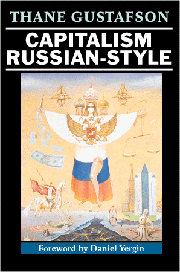Book contents
- Frontmatter
- Contents
- Foreword by Daniel Yergin
- Acknowledgments
- Prologue
- 1 The new Russian Revolution: false start or dead end?
- 2 Creating owners: insider privatization and its consequences
- 3 Wall Street comes to Moscow
- 4 The rise and fall of the private banks
- 5 No capitalism without capitalists: entrepreneurship in the new Russia
- 6 Russia's epidemic of crime
- 7 Toward the rule of law?
- 8 Beyond coping: toward the recovery of Russian society
- 9 The shrinking Russian state and the battle for taxes
- 10 Conclusion: halfway to the market Russia on the eve of the twenty-first century
- Bibliography
- Index
1 - The new Russian Revolution: false start or dead end?
Published online by Cambridge University Press: 22 September 2009
- Frontmatter
- Contents
- Foreword by Daniel Yergin
- Acknowledgments
- Prologue
- 1 The new Russian Revolution: false start or dead end?
- 2 Creating owners: insider privatization and its consequences
- 3 Wall Street comes to Moscow
- 4 The rise and fall of the private banks
- 5 No capitalism without capitalists: entrepreneurship in the new Russia
- 6 Russia's epidemic of crime
- 7 Toward the rule of law?
- 8 Beyond coping: toward the recovery of Russian society
- 9 The shrinking Russian state and the battle for taxes
- 10 Conclusion: halfway to the market Russia on the eve of the twenty-first century
- Bibliography
- Index
Summary
Tiumen, December 1992:
The sleepy central square of a typical Russian provincial capital. The new Russian tricolor floats over the former Communist Party headquarters, now renamed administratsiia. Above its Grecian columns the Russian two-headed eagle has replaced the hammer and sickle. But inside, the same policeman in grey uniform checks the documents of all who enter, and the same endless oriental carpets lead down the corridors of official doors, thickly padded with maroon leatherette.
In the closed executive lunchroom, located behind the public stolovaia of the administratsiia building, the local influentials, many now recast as private businessmen and traders, still meet for lunch every day. All are na ty – on a first-name basis – from their years together in the Soviet apparatus. Outside, in the central square, a marble statue of Lenin still points the way to the future.
Kaluga, June 1996:
We are sitting under the apple tree of Vadim and Marina's country dacha. It is a warm, lazy day in June. In the distance rise the tall stacks of the first Soviet nuclear reactor at Obninsk, now idle. As the bees buzz about the apple blossoms, Vadim is interpreting the Russian revolution.
“The real revolution came in 1992, when they decontrolled prices. Overnight, Russia became a money economy. You Americans have no idea what this means. Our whole life used to be built around the struggle to find things that were in short supply, defitsit – things everyone had to stand in line for. The search for things dominated your whole life; you organized every waking hour around it; you built your friendships around who could get you what; people took jobs just to have access to a flow of goods ‘on the inside.’”
Vadim sat back and smiled. “Now that's all gone. There is no more defitsit – except of money itself.”
- Type
- Chapter
- Information
- Capitalism Russian-Style , pp. 10 - 34Publisher: Cambridge University PressPrint publication year: 1999



